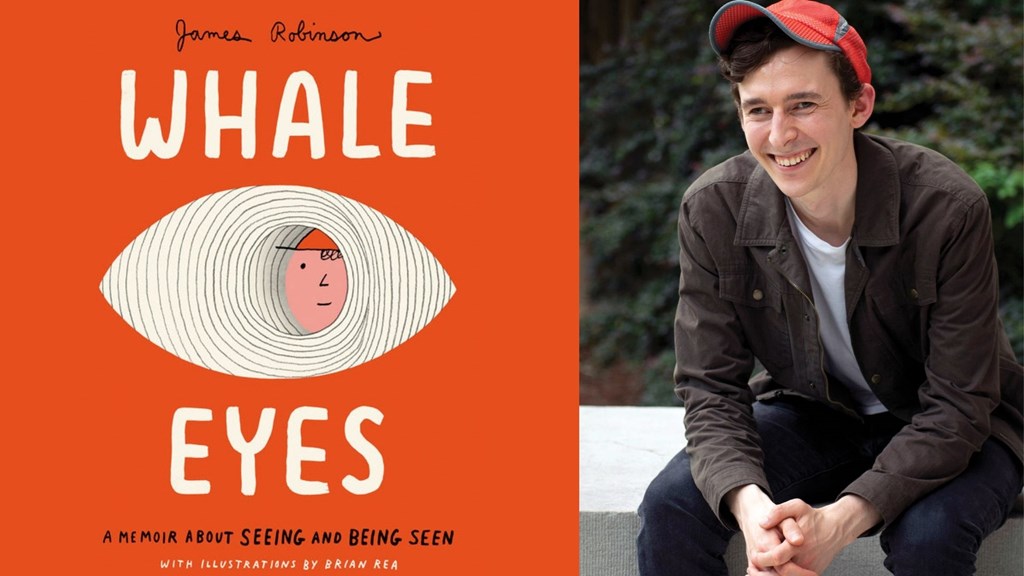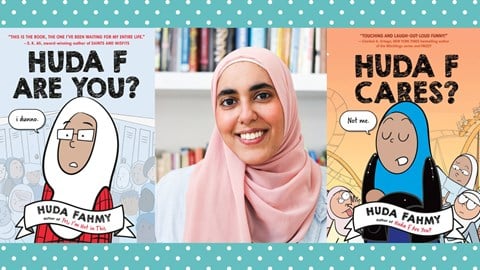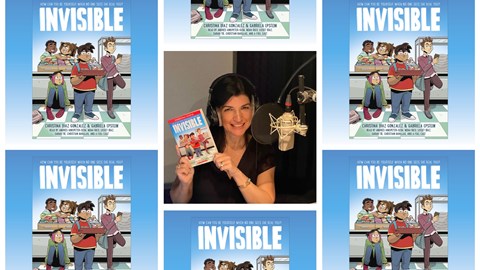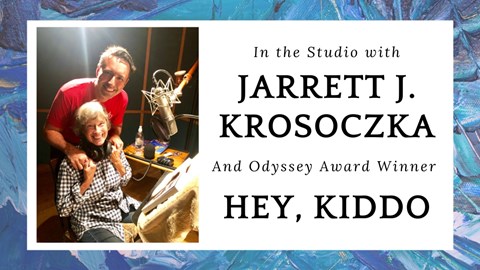AudioFile spoke with author and documentarian James Robinson and producer Iris McElroy about the audiobook adaptation of James’s memoir for middle-grade readers, WHALE EYES.
AudioFile: We appreciate audiobooks that add a new dimension to the medium. Transforming an extensively illustrated print book about a visual disability (which you endearingly call “whale eyes”) into an audiobook was a bold undertaking. When you wrote the book, did you already have a commitment to publish in audio format as well? Were you apprehensive about the challenge?
 James Robinson: So much of the evolution of WHALE EYES from film to book to audiobook has been about finding a dynamic way for the story to resonate within each medium. In the original film, I enabled the audience to experience the world through my jumpy, alternating vision. In the physical book, I frustrate fluent readers as they struggle to make their way through text that has been intentionally made difficult to decipher. I thought about the audiobook quite a bit while I was writing, and my interest was to push this form in new ways. And as is so often the case, the biggest roadblocks became the most ripe opportunities, including sharing recordings of the candid responses of those trying to decipher the text with no idea of how to tackle what was in their hands.
James Robinson: So much of the evolution of WHALE EYES from film to book to audiobook has been about finding a dynamic way for the story to resonate within each medium. In the original film, I enabled the audience to experience the world through my jumpy, alternating vision. In the physical book, I frustrate fluent readers as they struggle to make their way through text that has been intentionally made difficult to decipher. I thought about the audiobook quite a bit while I was writing, and my interest was to push this form in new ways. And as is so often the case, the biggest roadblocks became the most ripe opportunities, including sharing recordings of the candid responses of those trying to decipher the text with no idea of how to tackle what was in their hands.
AF: James, as a child who had difficulty reading, you listened to a lot of audiobooks. What did you want to bring to WHALE EYES that was missing in the books/audiobooks of your youth?
JR: I wanted to convey to audiences that the audiobook is a perfectly acceptable way to consume a book. That there was no shame. And also, that I, as an author, cared just as much about their experience as I did those who read a physical copy of the book. It's not a secondary experience or an afterthought.
I also wanted to keep in mind that some listeners would follow along in the physical book as they listened to the words read aloud to them. I wanted to ensure that the additions that I was making to the audiobook wouldn’t distract or disrupt their interactions with the physical copy of the book.
AF: The book uses several clever devices to render the book’s intrinsic images as audio. Whose idea was it to record the confused conversations and reactions of James’s friends and family when they try to interpret the world as he sees it? Brilliant!
JR: The first time that I heard someone read portions of the deconstructed text out loud, I was struck that they sounded exactly like me when I was a child struggling to read. And most unexpectedly, I suddenly found myself in the role of reading coach, encouraging them not to run away. Hearing my AP English teacher genuinely struggling to read, just as I had in first grade, resonated in a way that I knew needed to be included in the audiobook. As I filmed more teachers, students and parents reading the book, their collective voices brought the freshness to life. I brought this up with Iris, who approached this project with such an open mind and eagerness to experiment. I was so lucky to have such a great partner.
Iris McElroy: This was all James! We had multiple conversations about adapting the visual elements of the book before and during recording. We wanted the audiobook to be as accessible as possible for listeners with visual conditions, which meant stepping outside the box in terms of classic audiobook production. Right off the bat, James came to the table with a clear idea of what he wanted this to sound like. I deferred to him often during this process since this is his experience and he is such an avid audiobook listener. I loved including these clips because it felt like a call back to the videos that he produced with the New York Times, which I thought were brilliant. After our initial recording, James worked independently to record his family and friends and sent us the clips to include in the edit. This was a true collaboration!
AF: Iris, there's a ticking clock to convey the uncomfortable feeling that young James experienced while classmates waited for him to finish any task requiring reading. The effects in WHALE EYES are perfectly placed. How do you decide what’s enough? What’s too much?
IM: While we both had thoughts on the design during preproduction, the full sound production ideas came together during the recording process. I don’t know if there’s a hard-and-fast rule to deciding when sound design is too much; I think a lot of it is based on a feeling. My thought is if the design overpowers the performance or distracts from the storytelling, then it needs to be dialed back. I had the pleasure of directing James, and we would often stop and discuss sound design ideas during recording. I think because James is also a producer, a lot of these ideas came together organically. He already had an innate sense of what he wanted, and there were moments where we discussed adding music here or cutting a clip or lines there.
AF: James, WHALE EYES is classified as a “middle grade” book; however, much of the book focuses on your experiences as a documentarian and your adult life—although you’re still quite young! You seem to have found a “sweet-spot”—a book that is relevant to children and adults. Was that intentional?
JR: I always viewed my audience for this work as similar to the audience of the film “Whale Eyes” that I made for New York Times Opinion. It would certainly need to be accessible to middle-grade readers, but I also knew that it could break the traditional age boundaries. So much of this book is about rewriting the story that we tell ourselves about differences and disabilities. And that’s a process that is universal, but happens at many different ages.
I’ve had numerous reminders of how important the adult audience is, including when my first grade teacher read the book said—"Oh, if I'd only read this when I had you as a student, it would have changed the way I taught you.”
AF: Did you consult with the illustrator, Brian Rea, to ensure that you conveyed the right message for each image from the book?
JR: So much of the process with Brian felt like we were always seeing more than what was simply on the page. I wrote out ideas, and he came back with sketches. Then I provided feedback, and he refined. That’s how it worked practically, but what made the process extraordinary was seeing Brian layer meaning and convey key emotions within the economy of a few simple lines. The illustration descriptions I put together for the audiobook are in many ways a thank you to Brian for the depth and care he put into telling this story.
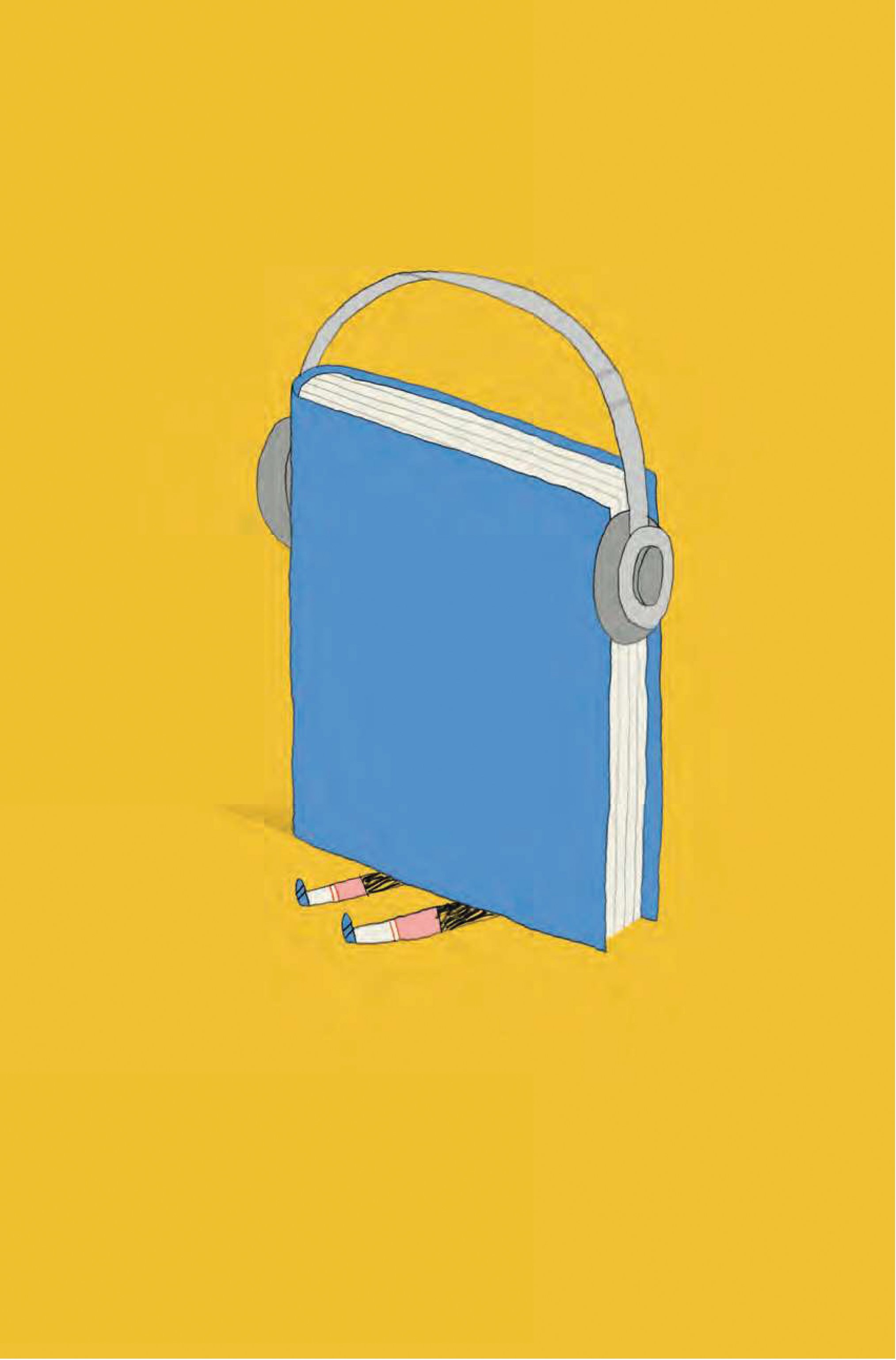
AF: James, you are an Emmy award-winning documentarian who attended Duke’s Center for Documentary Studies. What documentarian’s skills did you use for WHALE EYES?
JR: So much of the documentary process involves using the form to tell a story in the most compelling way possible. For example, as I was writing the book, I initially had a chapter on starers. But as I worked through the text, it turned out that bundling the starers into a single chapter didn't embody their disruptive nature. So I chopped the chapter into slivers that interrupt the reader throughout the book. I then addressed the silence that often accompanies a stare by writing postcards to the starers—filling that silent gap with what I wished I could say to them in the moment.
AF: James, in your book you shine a light on people with disabilities and exploited children in the global workforce. You offer strategies for cultivating care and concern for people with specific disabilities or difficulties. Obviously, you can only speak to your own experience and generation, but overall are you hopeful about the future?
JR: In the book I write about false hope—how hope that’s founded in a specific future outcome can be unrealistic and unproductive. But my eyes have led me to discover another type of hope—a hope that we can place in people, in the connections that we form every day when we embrace each other’s differences rather than skirt around them. I try to focus on this type of hope—which is foundational to my worldview and the work I do.
AF: Is there anything else that you would like to share about WHALE EYES?
IM: For me, this was a dream project. I love productions in which I get to help tell stories that are so different from my own. I learned so much from James, not only about his story, but about being a creative. It was great fun, and I hope listeners enjoy it as much as I did.
—
Lisa Taylor is an AudioFile reviewer
Author photo by Susie Post Rust; illustration from WHALE EYES ©Penguin Workshop/Brian Rea


